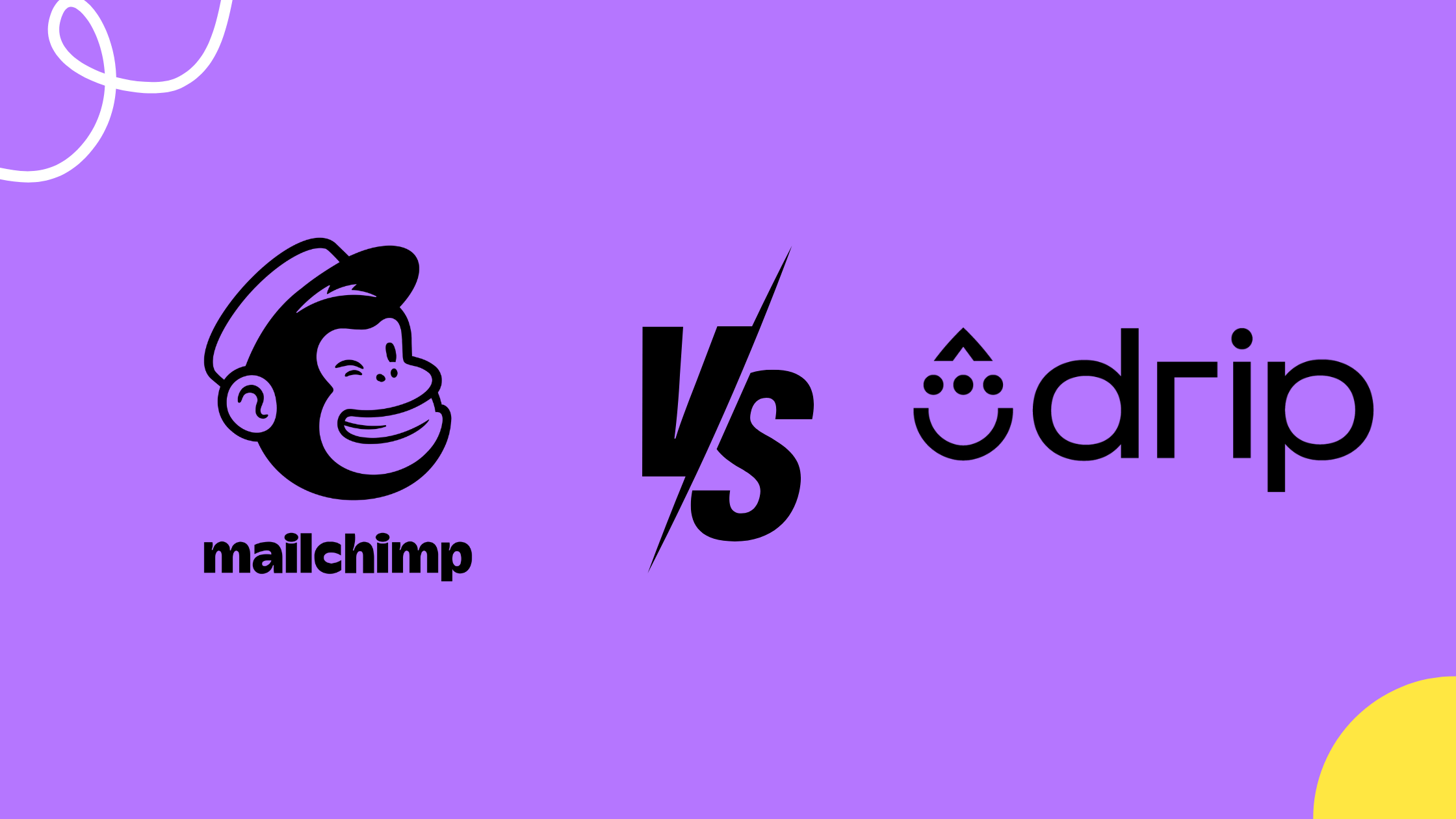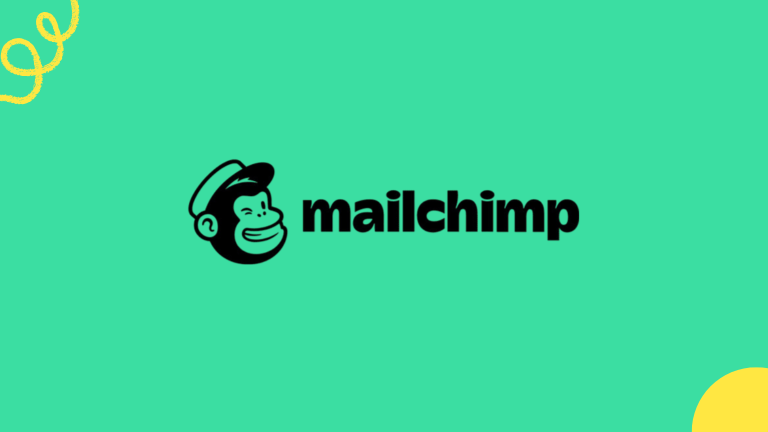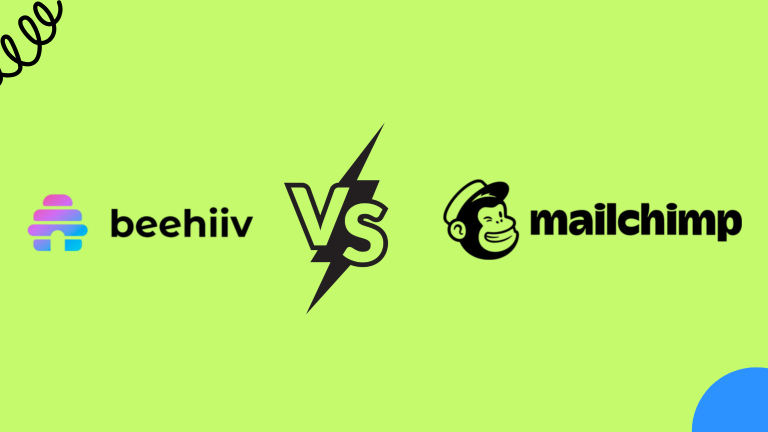Table of Contents
Drip vs Mailchimp
When it comes to email marketing, choosing the right platform can significantly impact your business’s ability to engage with customers, automate marketing tasks, and drive sales. Drip and Mailchimp are two of the most popular options, but they cater to different needs. Mailchimp is a well-known, versatile platform used by businesses of all sizes, while Drip is specifically tailored for eCommerce businesses looking for advanced automation and customer relationship management (CRM) capabilities.
In this article, we’ll dive deep into the features, pricing, and advantages of both platforms, so you can decide which one is right for you.
What is Drip?
Drip is a powerful email marketing platform designed primarily for eCommerce businesses. Founded in 2013, it focuses on delivering personalized marketing automation that drives online sales. Unlike more general-purpose email marketing platforms, Drip’s strength lies in its ability to provide highly targeted email campaigns and track customer behavior across multiple channels.
Key Features of Drip
- Advanced Marketing Automation: Drip offers highly customizable workflows based on customer behavior, shopping patterns, and engagement.
- CRM Capabilities: Built-in CRM allows businesses to manage and nurture customer relationships without the need for third-party tools.
- E-commerce Integrations: Drip integrates seamlessly with platforms like Shopify, WooCommerce, and Magento, offering robust eCommerce solutions.
- Segmentation and Personalization: Detailed segmentation based on customer activity, preferences, and purchase history.
- Multi-channel Campaigns: Run email, SMS, and social media retargeting campaigns from one platform.
What is Mailchimp?
Mailchimp, founded in 2001, is a leading all-in-one marketing platform that offers more than just email marketing. It provides tools for creating landing pages, managing social media ads, running automation campaigns, and analyzing audience engagement. Its user-friendly interface and a wide range of features make it a popular choice for small businesses and startups.
Key Features of Mailchimp
- Drag-and-Drop Editor: Mailchimp’s intuitive email builder allows you to create visually appealing campaigns with no coding skills.
- Automation: Automate workflows like welcome emails, product recommendations, and cart abandonment messages.
- Detailed Analytics: Offers in-depth reporting on open rates, click rates, and audience engagement.
- Templates and Design Flexibility: Mailchimp offers a wide variety of pre-designed email templates that can be customized for branding.
- Integrations: Integrates with over 250 tools, including major eCommerce platforms, CRM systems, and marketing tools.
Pricing Comparison: Drip vs Mailchimp
| Plan | Drip | Mailchimp |
|---|---|---|
| Free Plan | No free plan, but a 14-day free trial is available. | $0/month – 500 contacts – 1,000 emails/month – Limited features – 30-day email support |
| Basic/Paid Plan | $39/month for 2,500 contacts – Unlimited email sends – Full feature access – Email support | $13/month (Essentials) for 500 contacts – 5,000 emails/month – Custom templates, basic automation |
| Mid-Tier Plan | $99/month for 5,000 contacts – Unlimited email sends – Advanced support (email and chat) – Full automation, SMS marketing | $20/month (Standard) for 500 contacts – Advanced automation, A/B testing – Custom branding |
| Premium Plan | $299/month for 10,000 contacts – Unlimited email sends – Dedicated customer success manager – Advanced analytics, SMS, and migration services | $350/month for 10,000 contacts – Advanced segmentation, multivariate testing – Phone support |
| High-Volume Plan | Custom pricing for 100,000+ contacts – Unlimited email sends – Priority support, dedicated account manager | Custom pricing for 200,000+ contacts – Advanced automation and priority support |
Drip’s Pricing
Drip offers a 14-day free trial, after which its pricing starts at $39 per month for up to 2,500 subscribers. Pricing increases based on the number of contacts, but you get access to all features regardless of plan size. For eCommerce businesses that need advanced automation and segmentation, Drip provides excellent value for money, though it’s more expensive than Mailchimp for smaller lists.
Mailchimp’s Pricing
Mailchimp offers a free plan with up to 500 contacts and 1,000 email sends per month, which is great for businesses just starting out. Paid plans start at $13 per month, with pricing scaling up based on the number of contacts and features required. While Mailchimp’s free tier is appealing, its pricing can become more expensive than Drip once your list grows beyond 10,000 contacts.
Which Platform Offers Better Value?
If you’re a small business with a limited budget, Mailchimp’s free plan or lower-tier options may be more suitable. However, for eCommerce businesses looking to leverage advanced automation, customer tracking, and CRM features, Drip offers better value despite its higher starting price.
User Interface and Ease of Use
Drip’s User Experience
Drip has a clean, modern interface but is slightly more complex due to its focus on automation and CRM. It’s designed for marketers who want to build detailed workflows and track customer journeys across multiple touchpoints. While it may have a steeper learning curve, it offers more advanced tools for experienced users.
Mailchimp’s User Experience
Mailchimp is known for its beginner-friendly interface. Its drag-and-drop editor and straightforward navigation make it easy for users with little to no experience to design emails and manage campaigns. However, its simplicity can be limiting for advanced marketers who want more control over segmentation and automation.
Automation Features: Drip vs Mailchimp
Drip’s Automation
Drip excels in marketing automation. It offers a visual workflow builder that lets you create complex, multi-step workflows based on customer behavior, like abandoned carts, product recommendations, and personalized follow-up emails. The automation is highly customizable, allowing for precise targeting based on specific actions or events.
Mailchimp’s Automation
Mailchimp’s automation tools are user-friendly and come with pre-built workflows for common scenarios like onboarding and abandoned carts. However, its automation capabilities are not as advanced or flexible as Drip’s. For businesses that need simple automation, Mailchimp’s options may be sufficient, but those looking for more robust features will find Drip to be a better choice.
Audience Segmentation and Personalization
Drip’s Segmentation and Personalization
Drip’s segmentation is highly detailed, allowing businesses to create custom segments based on customer actions, website behavior, purchase history, and engagement with email campaigns. This level of granularity enables businesses to send highly personalized messages at the right time, significantly improving conversion rates.
Mailchimp’s Segmentation and Personalization
Mailchimp also offers segmentation tools, but they are more basic compared to Drip. You can create segments based on location, purchase history, and engagement, but the depth of segmentation isn’t as robust. For businesses that don’t require hyper-targeted campaigns, Mailchimp’s segmentation tools will be adequate.
E-commerce Features: Drip vs Mailchimp
Drip’s E-commerce Focus
Drip is specifically designed for eCommerce businesses, and its features reflect that focus. From integration with Shopify and WooCommerce to detailed customer tracking and product recommendations, Drip provides everything an online store needs to engage customers, drive sales, and track customer journeys from start to finish.
Mailchimp’s E-commerce Features
Mailchimp also integrates with eCommerce platforms like Shopify and WooCommerce, but its eCommerce tools are more basic compared to Drip. Mailchimp offers abandoned cart emails and product recommendations, but lacks the same level of in-depth tracking and automation that Drip provides.
CRM Features Comparison
Drip’s CRM Capabilities
Drip includes built-in CRM features, allowing businesses to manage customer relationships directly within the platform. You can track customer interactions, see lifetime value, and manage leads without needing a separate CRM tool. This is particularly useful for eCommerce businesses that want a complete view of their customer journey.
Mailchimp’s CRM Capabilities
Mailchimp offers basic CRM features, including contact profiles and customer insights, but it doesn’t match the depth of Drip’s CRM functionality. Mailchimp is better suited for businesses that don’t need comprehensive CRM capabilities or already use a separate CRM system.
Deliverability and Email Performance
Drip’s Deliverability
Drip has strong deliverability rates, especially for eCommerce-focused campaigns. Its deliverability tools help ensure that emails reach the inbox rather than the spam folder, and Drip offers real-time tracking and insights into email performance.
Mailchimp’s Deliverability
Mailchimp is also known for its excellent deliverability rates. The platform provides tools to help users improve deliverability, such as email content guidelines and authentication protocols like DKIM and SPF.
Customer Support and Resources
Drip’s Support
Drip provides live chat and email support, along with a comprehensive knowledge base. Their customer service is well-regarded, particularly for users on higher-tier plans who need help with advanced features or integrations.
Mailchimp’s Support
Mailchimp offers email and live chat support, but live chat is only available on paid plans. The platform also has a detailed knowledge base and tutorials to help users get the most out of their campaigns.
Integrations and Third-Party Tools
Drip’s Integrations
Drip integrates with a wide variety of eCommerce tools, including Shopify, WooCommerce, and Magento. It also connects with platforms like Facebook Ads, Google Ads, and Zapier, making it easy to sync customer data across different channels and tools.
Mailchimp’s Integrations
Mailchimp integrates with over 250 apps and platforms, including major eCommerce platforms, CRMs, and social media tools. This makes it versatile and adaptable for businesses with a range of marketing and customer management needs.
Who Should Choose Drip?
Drip is the best choice for eCommerce businesses that need advanced automation, detailed customer tracking, and multi-channel marketing capabilities. It’s ideal for companies that want to go beyond simple email campaigns and leverage sophisticated workflows and personalization to drive sales.
Who Should Choose Mailchimp?
Mailchimp is a great option for small businesses, startups, or those new to email marketing who need an affordable, easy-to-use platform. It’s also a good fit for businesses that require basic email marketing and automation features without the complexity of a dedicated eCommerce solution.
Conclusion
Both Drip and Mailchimp are excellent email marketing platforms, but they serve different types of businesses. Drip is specifically designed for eCommerce companies that need advanced automation, personalization, and CRM capabilities, while Mailchimp is a more general-purpose platform that works well for small businesses and those just getting started with email marketing.
If you’re running an online store and need sophisticated tools to track and engage customers, Drip is the better choice. However, if you’re a small business looking for a user-friendly and affordable solution to manage email campaigns, Mailchimp is likely a better fit.
FAQs
u003cstrongu003eWhich platform is better for eCommerce businesses?u003c/strongu003e
Drip is better suited for eCommerce businesses due to its advanced automation, segmentation, and CRM features.
u003cstrongu003eIs Mailchimp cheaper than Drip?u003c/strongu003e
Yes, Mailchimp is more affordable, especially for small businesses or those just starting with email marketing. Drip is pricier but offers more advanced features for eCommerce.
u003cstrongu003eCan I switch from Mailchimp to Drip?u003c/strongu003e
Yes, both platforms allow you to export and import contacts, though you may need to recreate email templates and workflows when switching.
u003cstrongu003eDoes Drip offer a free plan?u003c/strongu003e
No, Drip offers a 14-day free trial, but its paid plans start at $39/month. Mailchimp, on the other hand, offers a free plan for up to 500 contacts.
u003cstrongu003eWhich platform offers better automation features?u003c/strongu003e
Drip offers more advanced and customizable automation features, making it a better choice for businesses that need detailed workflows.
u003cstrongu003eCan you do a drip campaign in Mailchimp?u003c/strongu003e
Yes, you can create drip campaigns in Mailchimp using their Customer Journey Builder. This feature allows you to automate a series of emails based on user actions, such as sign-ups or purchases. You can set triggers, delays, and conditions to personalize the journey for each recipient. While the tool is effective, some users find it lacks the depth of automation seen in other platforms like ActiveCampaign. For simple drip campaigns, though, Mailchimp gets the job done efficiently.
u003cstrongu003eAre there better alternatives to Mailchimp?u003c/strongu003e
Yes, depending on your needs. Platforms like ActiveCampaign offer more robust automation, ideal for complex drip campaigns and advanced customer segmentation. ConvertKit is excellent for creators, focusing on ease of use and advanced tagging. If you’re looking for more budget-friendly options, MailerLite and Moosend provide similar features to Mailchimp but with better pricing. u003ca href=u0022https://saaspenguin.com/brevo-vs-mailchimpu0022u003eSendinblueu003c/au003e is another strong contender, offering SMS marketing alongside email, giving more flexibility for multi-channel marketing.





